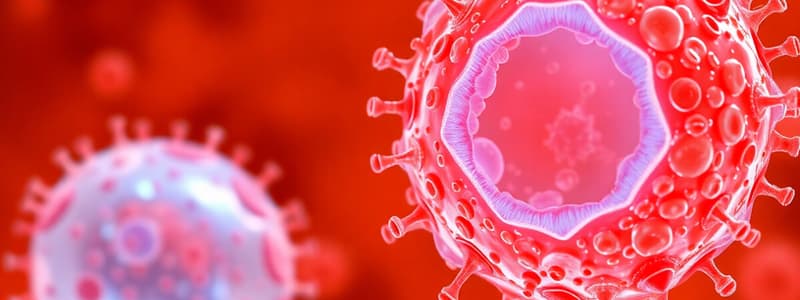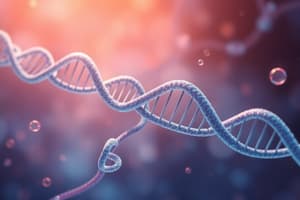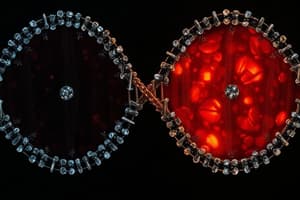Podcast
Questions and Answers
What occurs during Prophase II of meiosis?
What occurs during Prophase II of meiosis?
- Chromosomes form tetrads and exchange genetic material.
- Sister chromatids align at the equator.
- The nucleolus disappears and chromatin condenses.
- Centrioles move to opposite poles and spindle fibers start to appear. (correct)
What characterizes Anaphase II in meiosis?
What characterizes Anaphase II in meiosis?
- Chromosomes align at the center of the cell.
- Cytokinesis occurs, forming two haploid cells.
- Homologous chromosomes separate and move to opposite poles.
- Sister chromatids separate at the centromeres. (correct)
How many chromosomes are present at each pole after Anaphase II is complete?
How many chromosomes are present at each pole after Anaphase II is complete?
- 46 single chromosomes.
- 23 homologous pairs.
- 23 single chromosomes. (correct)
- 46 paired chromosomes.
What process contributes to genetic variation during meiosis?
What process contributes to genetic variation during meiosis?
What happens during Telophase II?
What happens during Telophase II?
What is the primary function of the sperm produced during spermatogenesis?
What is the primary function of the sperm produced during spermatogenesis?
Which statement about oogenesis is correct?
Which statement about oogenesis is correct?
When does meiosis I in females typically resume after being suspended?
When does meiosis I in females typically resume after being suspended?
What is the result of the division of an oogonium in the female fetus?
What is the result of the division of an oogonium in the female fetus?
Which of the following correctly describes spermatogenesis?
Which of the following correctly describes spermatogenesis?
What type of cells are described as having two sets of similar chromosomes?
What type of cells are described as having two sets of similar chromosomes?
What term describes the process through which genetic material from two parental cells is combined?
What term describes the process through which genetic material from two parental cells is combined?
What is the haploid number of chromosomes in human gametes?
What is the haploid number of chromosomes in human gametes?
Which of the following is NOT a characteristic of asexual cell reproduction?
Which of the following is NOT a characteristic of asexual cell reproduction?
What happens to the chromosome number when a sperm fertilizes an egg?
What happens to the chromosome number when a sperm fertilizes an egg?
What is the purpose of reducing the chromosome number in gametes during sexual reproduction?
What is the purpose of reducing the chromosome number in gametes during sexual reproduction?
What is the diploid number of chromosomes in humans?
What is the diploid number of chromosomes in humans?
Which type of cells give rise to gametes such as eggs and sperm?
Which type of cells give rise to gametes such as eggs and sperm?
What is the result of nondisjunction during cell division?
What is the result of nondisjunction during cell division?
What defines the male zygote in terms of sex chromosomes?
What defines the male zygote in terms of sex chromosomes?
What is the outcome of crossbreeding a water-melon with 8n ploidy and one with 6n ploidy?
What is the outcome of crossbreeding a water-melon with 8n ploidy and one with 6n ploidy?
What characteristic do mules possess that makes them sterile?
What characteristic do mules possess that makes them sterile?
What does the presence of the TDF gene signify in a zygote?
What does the presence of the TDF gene signify in a zygote?
What type of chromosomal mutation occurs if an individual has three copies of a chromosome?
What type of chromosomal mutation occurs if an individual has three copies of a chromosome?
What causes seedless fruits to be produced?
What causes seedless fruits to be produced?
Which statement correctly describes the behavior of primary oocytes?
Which statement correctly describes the behavior of primary oocytes?
What is the ploidy of the spores produced through meiosis?
What is the ploidy of the spores produced through meiosis?
What process occurs to produce sperm and egg cells in the life cycle of moss?
What process occurs to produce sperm and egg cells in the life cycle of moss?
What is the process noted as B in the development of a multicellular gametophyte from a single spore?
What is the process noted as B in the development of a multicellular gametophyte from a single spore?
What type of twins form when two eggs are fertilized simultaneously?
What type of twins form when two eggs are fertilized simultaneously?
Which type of stem cell can develop into any tissue and forms all parts of the embryo?
Which type of stem cell can develop into any tissue and forms all parts of the embryo?
What advantage does asexual reproduction provide to simple organisms like bacteria?
What advantage does asexual reproduction provide to simple organisms like bacteria?
What is a common misconception about identical twins?
What is a common misconception about identical twins?
What significant applications can emerge from stem cell research?
What significant applications can emerge from stem cell research?
Flashcards are hidden until you start studying
Study Notes
Cellular Reproduction Overview
- Two main cell types in the human body: somatic (body) cells and germ (gamete) cells.
- Somatic cells are diploid (2n), containing two sets of chromosomes.
- Germ cells are haploid (n), with a single set of chromosomes, producing gametes (eggs and sperm).
Asexual Reproduction
- Asexual reproduction involves no genetic variation; new cells are genetically identical to the original cell.
- Common in organisms and somatic cells for growth, repair, and replacing old cells.
Sexual Reproduction
- Introduces genetic variation through the fusion of genetic material from two parental cells.
- Gametes have half the chromosome number; fertilization restores the diploid number (2n).
- In humans, gametes contain 23 single chromosomes, leading to a total of 46 chromosomes upon fertilization.
Chromosome Count in Organisms
- Various species have distinct diploid chromosome numbers (e.g., cats 38, dogs 78, horses 64).
- Human diploid number is 46 (23 pairs).
Meiosis Process
- Meiosis II resembles mitosis but occurs in haploid cells.
- Stages in Meiosis II:
- Prophase II: Centrioles separate and spindle fibers form.
- Metaphase II: Chromosomes align at cell center.
- Anaphase II: Sister chromatids separate, moving to opposite poles.
- Telophase II: Chromosomes uncoil, nuclear envelope reappears, followed by cytokinesis.
Genetic Variation Sources
- Crossing over during Prophase I and independent assortment during Meiosis I contribute to genetic diversity.
- In humans, with 23 chromosome pairs, over 8 million different gametes can be produced.
Gametogenesis
- Spermatogenesis: Production of sperm in males, occurring continuously post-puberty; results in four small, motile sperm cells.
- Oogenesis: Formation of mature egg cells in females, typically producing one ovum and three polar bodies; begins before birth and is arrested until puberty.
Genetic Sex Determination
- A zygote's sex is determined by sex chromosomes: XX for female and XY for male.
- The Y chromosome carries the Testes Determining Factor (TDF).
Nondisjunction and Chromosomal Mutations
- Nondisjunction occurs when chromosomes fail to separate during cell division, leading to aneuploidy (trisomy or monosomy).
- Seedless fruits are often a result of induced nondisjunction.
Ploidy Levels
- Crossbreeding different ploidy plants can result in sterile offspring when the resulting hybrid has an odd ploidy number.
Asexual Reproductive Strategies
- Simple organisms, fungi, and some plants often reproduce asexually, which can be advantageous for rapid population increase.
Stem Cells
- Types of stem cells:
- Pluripotent: Can develop into multiple specialized cells.
- Totipotent: Can develop into all cell types in an organism, significant for research.
Potential of Stem Cell Research
- Organ cloning from adult stem cells could reduce rejection issues and wait times for organ transplants.
Twins
- Identical twins originate from one fertilized egg that splits, sharing identical DNA.
- Fraternal twins result from two separate eggs fertilized simultaneously, leading to genetic diversity between the siblings.
Studying That Suits You
Use AI to generate personalized quizzes and flashcards to suit your learning preferences.




